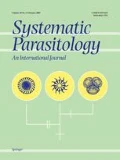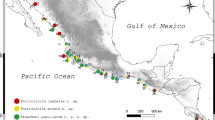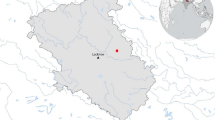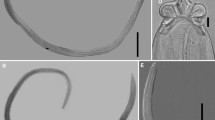Abstract
Members of Forticulcitinae Blasco-Costa, Balbuena, Kostadinova & Olson, 2009 include endoparasites of mullet fishes distributed worldwide. Adult specimens were collected from the intestines of white mullet (Mugil curema) and flathead grey mullet (Mugil cephalus) from five localities in the Gulf of Mexico and a single locality in Venezuela. Photogenophores were sequenced for two nuclear molecular markers, the large subunit (LSU) and second internal transcribed spacer (ITS2) of nuclear rDNA. The new sequences were aligned with other sequences downloaded from GenBank. The maximum likelihood and Bayesian inferences were deduced using the combined dataset (LSU + ITS2). The phylogenetic analyses revealed four new lineages belonging to Forticulcitinae. Three new species are described in the present study. Ekuarhuni mexicanus n. sp. can be differentiated from its congeneric species by presenting a longer hermaphroditic sac length (136–180 μm) and a wider testis (91–123 μm). Forticulcita macropharyngis n. sp. and Forticulcita venezuelensis n. sp. are the 8th and 9th species described in Forticulcita. Both species belong to the diminutive morphotype of Forticulcita. Forticulcita macropharyngis n. sp. can be morphologically distinguished from the other congeneric species by the presence of a massive and muscular pharynx (46–110 μm long, 74–106 μm wide). Forticulcita venezuelensis n. sp. is the second species of the studied genus recorded in South America and can be differentiated from congeneric species by possessing the largest testis (138–201 μm long, 83–100 μm wide). Finally, the fourth lineage corresponds to Overstreetoides Andrade-Gómez & García-Varela, 2021; however, few specimens of this lineage were collected, precluding any description of the species. In addition, a key is proposed for differentiating the genera and species of Forticulcitinae.





Similar content being viewed by others
References
Andrade-Gómez, L., & García-Varela, M. (2021). Unexpected morphological and molecular diversity of trematode (Haploporidae: Forticulcitinae) parasites of mullets from the ocean Pacific coasts in Middle America. Parasitology Research, 120, 55–72. https://doi.org/10.1007/s00436-020-06983-y
Andres, M. J., Pulis, E. E., Curran, S. S., & Overstreet, R. M. (2018). On the systematics of some marine haploporids (Trematoda) with the description of a new species of Megasolena Linton, 1910. Parasitology International, 67, 805–815. https://doi.org/10.1016/j.parint.2018.08.002
Andres, M. J., Curran, S. S., Fayton, T. J., Pulis, E. E., & Overstreet, R. M. (2015). An additional genus and two additional species of Forticulcitinae (Digenea: Haploporidae). Folia Parasitologica, 62, 025. https://doi.org/10.14411/fp.2015.025
Atopkin, D. M., Besprozvannykh, V. V., Ha, D. N., Nguyen, V. H., Nguyen, V. T., & Chalenko, K. P. (2019). A new subfamily, Pseudohaploporinae subfam. n. (Digenea: Haploporidae), with morphometric and molecular analyses of two new species: Pseudohaploporus vietnamensis n. g., sp. n. and Pseudohaploporus planilizum n. g., sp. n. from Vietnamese mullet. Parasitology International, 69, 17–24. https://doi.org/10.1016/j.parint.2018.11.001
AVMA (American Veterinary Medical Association) (2013). Guidelines for the euthanasia of animals. Schaumburg, Illinois: American Veterinary Medical Association.
Blasco-Costa, I., Balbuena, J. A., Kostadinova, A. A., & Olson, P. D. (2009a). Interrelationships of the Haploporinae (Digenea: Haploporidae): a molecular test of the taxonomic framework based on morphology. Parasitology International, 58, 263–269. https://doi.org/10.1016/j.parint.2009.03.006
Blasco-Costa, I., Montero, F. E., Balbuena, J. A., Raga, J. A., & Kostadinova, A. A. (2009b). A revision of the Haploporinae Nicoll, 1914 (Digenea: Haploporidae) from mullets (Mugilidae): Dicrogaster Looss, 1902 and Forticulcita Overstreet, 1982. Systematic Parasitology, 72, 187–206. https://doi.org/10.1007/s11230-008-9165-3
Bush, A. O., Lafferty, K. D., Lotz, J. M., Shostak, A., Parasitology, W., meets ecology on its own terms: Margolis, , et al. (1997). revisited. Journal of Parasitology, 83, 575–583. https://doi.org/10.2307/3284227
Choudhury, A., García-Varela, M., & Pérez-Ponce de León, G. (2017). Parasites of freshwater fishes and the Great American Biotic Interchange: a bridge too far? Journal of Helminthology, 91, 174–196. https://doi.org/10.1017/S0022149X16000407
Coates, A. G., & Obando, J. A. (1996). The geologic evolution of the Central American isthmus. pp. 21–56. in Jackson, J. B. C., Budd, A.F. & Coates, A. G. (Eds). Evolution and environment in tropical America. Chicago University, Chicago, EEUU.
Curran, S. S., Pulis, E. E., Andres, M. J., & Overstreet, R. M. (2018). Two new species of Saccocoelioides (Digenea: Haploporidae) with phylogenetic analysis of the family, including species of Saccocoelioides from North, Middle and South America. Journal of Parasitology, 104, 221–239. https://doi.org/10.1645/17-189
Czaja, A., Meza-Sánchez, I. G., Estrada-Rodríguez, J. L., Romero-Méndez, U., Sáenz-Mata, J., Ávila-Rodríguez, V., Becerra-López, J. L., Estrada-Arellano, J. R., Cardoza-Martínez, G. F., Aguillón-Gutiérrez, D. R., Cordero-Torres, D. G., & Covich, A. P. (2020). The freshwater snails (Mollusca: Gastropoda) of Mexico: Updated checklist, endemicity hotspots, threats and conservation status. Revista Mexicana de Biodiversidad, 91, e912909. https://doi.org/10.22201/ib.20078706e.2020.91.2909
Edgar, R. C. (2004). MUSCLE: Multiple sequence alignment with high accuracy and high throughput. Nucleic Acids Research, 32, 1792–1797.
González-Ramírez, J., & Parés-Sierra, A. (2019). Streamflow modeling of five major rivers that flow into the Gulf of Mexico using SWAT. Atmósfera, 32, 261–272.
Gouy, M., Guindon, S., & Gascuel, O. (2010). SeaView version 4: A multiplatform graphical user interface for sequence alignment and phylogenetic tree building. Molecular Biology and Evolution, 27, 221–224. https://doi.org/10.1093/molbev/msp259
Hassanine, R. M. El-S. (2007). Trematodes from Red Sea fishes: Prosteganoderma brayi gen. nov., sp. nov. (Zoogonidae Odhner, 1902) and Forticulcita mugilis sp. nov. (Haploporidae Nicoll, 1914). Helminthologia, 44, 183–187.
Huelsenbeck, J. P., & Ronquist, F. (2001). MrBayes: Bayesian inference of phylogeny. Bioinformatics, 17, 754–755. https://doi.org/10.1093/bioinformatics/17.8.754
Huston, D. C., Cutmore, S. C., & Cribb, T. H. (2018). Isorchis cannoni n. sp. (Digenea: Atractotrematidae) from Great Barrier Reef rabbitfishes and the molecular elucidation of its life cycle. Journal of Helminthology, 92, 604–611. https://doi.org/10.1017/S0022149X17000906
ICZN. (2012). International Commission on Zoological Nomenclature: Amendment of articles 8, 9, 10, 21 and 78 of the International Code of Zoological Nomenclature to expand and refine methods of publication. Bulletin of Zoological Nomenclature, 69, 161–169.
Lado, P., Carnevia, D., Perretta, A., & Castro, O. (2013). Heleobia conexa (Mollusca, Cochliopidae) y Mugil platanus (Osteichthyes, Mugilidae), hospedador intermediario y definitivo de Dicrogaster fastigatus (Trematoda, Haploporidae) en Uruguay. Revista Argentina De Parasitologia, 2, 16–21.
Lessios, H. A. (2008). The Great American Schism: divergence of marine organisms after the rise of the Central American Isthmus. Annual Review of Ecology Evolution and Systematics, 39, 63–91.
Maddison, W. P., & Maddison, D. R. (2011). Mesquite: a modular system for evolutionary analysis. Version 2.75. Available at http://mesquiteproject.org (accessed 20 December 2020)
Miller, M.A., Pfeiffer, W., & Schwartz, T. (2010). Creating the CIPRES Science Gateway for inference of large phylogenetic trees. In: Proceedings of the Gateway Computing Environments Workshop (GCE), 14 November 2010, New Orleans, LA. pp. 1–8.
Nguyen, T., Speed, T.P. (1992). A Derivation of All Linear Invariants for a Nonbalanced Transversion Model. Journal of Molecular Evolution, 35(1), 60–76. https://doi.org/10.1007/BF00160261
Overstreet, R. M. (1982). Forticulcita glabra gen. et sp. n. (Digenea, Haploporidae) in a Red Sea mullet. Zoologica Scripta, 11, 83–85. https://doi.org/10.1111/j.1463-6409.1982.tb00520.x
Overstreet, R. M., & Curran, S. S. (2005). Family Haploporidae Nicoll, 1914. pp. 129–167 in Jones, A., Bray, R. A., & Gibson, D. I. (Eds) Keys to the Trematoda, Volume 2. Wallingford: CAB International and The Natural History Museum.
Pérez-Ponce de León, G., Sereno-Uribe, A., García-Varela, M., Mendoza-Garfias, B., Hernández-Mena, D., Pinacho-Pinacho, C., & Choudhury, A. (2020). Disentangling the evolutionary and biogeographical history of the freshwater fish trematode genus Creptotrema (Digenea: Allocreadiidae) using an integrative taxonomy approach: The case of Creptotrema agonostomi in Middle American mountain mullets. Journal of Helminthology, 94, E171. https://doi.org/10.1017/S0022149X2000053X
Posada, D. (2008). jModelTest: phylogenetic model averaging. Molecular Biology and Evolution, 25, 1253–1256. https://doi.org/10.1093/molbev/msn083
Pulis, E. E., & Overstreet, R. (2013). Review of haploporid (Trematoda) genera with ornate muscularisation in the region of the oral sucker, including four new species and a new genus. Systematic Parasitology, 84, 167–191. https://doi.org/10.1007/s11230-012-9401-8
Rambaut, A. (2012). FigTree v1.4.0. Institute of Evolutionary Biology. University of Edinburgh, UK.
Rosas-Valdez, R., Morrone, J. J., Pinacho-Pinacho, C. D., Domínguez-Domínguez, O., & García-Varela, M. (2020). Genetic diversification of acanthocephalans of the genus Floridosentis Ward 1953 (Acanthocephala: Neoechinorhynchidae), parasites of mullets from the Americas. Infection, Genetics and Evolution, 85, 104535. https://doi.org/10.1016/j.meegid.2020.104535
Silvestro, D., & Michalak, I. (2011). RaxmlGUI: a graphical front-end for RAxML. Organisms Diversity and Evolution, 12, 335–337.
Tamura, K., Stecher, G., Peterson, D., Filipski, A., & Kumar, S. (2013). MEGA6: molecular evolutionary genetics analysis version 6.0. Molecular Biology and Evolution, 30, 2725–2729.
Tavaré, S. (1986). Some probabilistic and statistical problems in the analysis of DNA sequences. Lectures on Mathematics in the Life Sciences, 17, 57–86.
Whitfield, A. K., Panfili, J., & Durand, J. D. (2012). A global review of the cosmopolitan flathead mullet Mugil cephalus Linnaeus 1758 (Teleostei: Mugilidae), with emphasis on the biology, genetics, ecology and fisheries aspects of this apparent species complex. Reviews in Fish Biology and Fisheries, 22, 641–681. https://doi.org/10.1007/s11160-012-9263-9
Acknowledgments
The first author thanks the support of the Programa de Posgrado en Ciencias Biológicas, UNAM and CONACYT (LAG CVU. No. 640068), for granting a scholarship to complete his PhD Program. In addition, we are grateful with Laura Marquez and Nelly López, LaNaBio for their help in sequencing DNA. We appreciate Jhonatan Granillo and Dr. Carlos D. Pinacho Pinacho for their help on the field work.
Funding
This research was supported by Grants from the Programa de Apoyo a Proyectos de Investigación e Innovación Tecnológica (PAPIIT-UNAM) IN207219.
Author information
Authors and Affiliations
Corresponding author
Ethics declarations
Conflict of interest
The authors declare that they have no conflict of interest.
Ethical approval
Specimens in Mexico were collected under the Cartilla Nacional de Colector Científico (FAUT 0202) issued by the Secretaría del Medio Ambiente y Recursos Naturales (SEMARNAT), to MGV. All applicable international, and institutional guidelines for the use and care of animals were followed.
Additional information
Publisher's Note
Springer Nature remains neutral with regard to jurisdictional claims in published maps and institutional affiliations.
Rights and permissions
About this article
Cite this article
Andrade-Gómez, L., González-García, M.T. & García-Varela, M. Phylogenetic affinities of Forticulcitinae (Haploporidae) parasites of mullet from the Americas, with the description of three new species and notes on the genera and key species. Syst Parasitol 98, 455–476 (2021). https://doi.org/10.1007/s11230-021-09989-x
Received:
Accepted:
Published:
Issue Date:
DOI: https://doi.org/10.1007/s11230-021-09989-x




